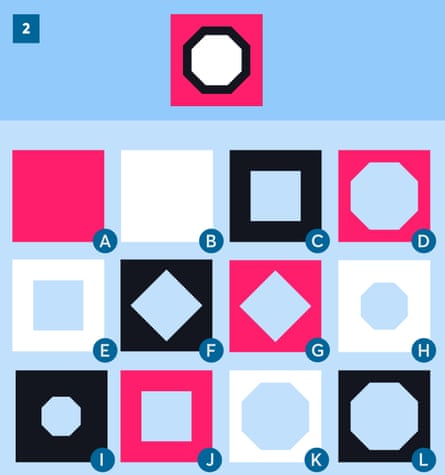Today’s puzzles are an intelligence test for children invented a century ago by an American psychologist, Grace Arthur.
You will be presented with a patterned square. The challenge is to work out how to create this square by placing some of the available stencils and coloured blocks on top of each other.
Easy, right? About 90 per cent of people (including adults) get this first example wrong:

Grace Arthur’s stencil test has an important role in the history of intelligence testing. She devised it in the 1920s because the other IQ tests used at the time relied on verbal responses, and hence discriminated against deaf people, or people from different cultural backgrounds such as native Americans. Her work helped change attitudes towards the intelligence of children from minority groups.
Arthur’s stencil test was used until the 1950s with stencils made out of cards, and examples are kept in museums of scientific instruments.
Recently, however, the test has been developed into an app, Stenciletto, by Jane Braybrook, the mother of a disabled son who uses it to help him with his cognitive development.
Jane has given the example above to friends, family, puzzle groups on social media, as well as clients of the learning disabilities charity Mencap, and says that 85 to 100 per cent of people get it wrong, depending on the forum.
Do you want to go back and check your answer? Most people make a mistake because they make impulsive decisions, whatever their IQ.
Now for five more Stenciletto puzzles, in increasing order of difficulty. Some of the questions have more than one correct answer. (More about Jane below.)





I’ll be back at 5pm UK with the answers.
PLEASE NO SPOILERS. Instead discuss issues surrounding IQ tests and non-verbal reasoning.
Jane Braybrook, who is from Nottingham, found out about Grace Arthur and her stencil test when she studied for a diploma in cognitive education in order to better understand her son’s cognitive impairment.
“Labels and IQ scores were not helpful to me as a mother, I needed practical advice on how to help him cope with his learning disabilities,” she says. She found a range of activities that her son enjoyed and was able to pass on information to his teachers and helpers to support his learning more effectively in school.
Her son wanted to play the stencil game but found mentally manipulating the shapes too hard. So she decided to turn it into an app, where you can move the stencils around to see what they look like when they overlap.
“I tried to get a hold of one of Grace Arthur’s stencil sets, only to discover they’re all in museums. And also, my son is extremely motivated by technology, so it was a logical decision to create a version for his mobile devices. In fact, he was so motivated that he learned to create puzzles, some of which are in the game, plus his friends at Mencap have been instrumental in testing it for us. The feedback so far has been very encouraging.”
Stenciletto is a free app available for iPhones on the AppStore , and for Android devices at Google Play. More information can be found here.
I set a puzzle here every two weeks on a Monday. I’m always on the look-out for great puzzles. If you would like to suggest one, email me.
I give school talks about maths and puzzles (online and in person). If your school (or police academy) is interested please get in touch.
